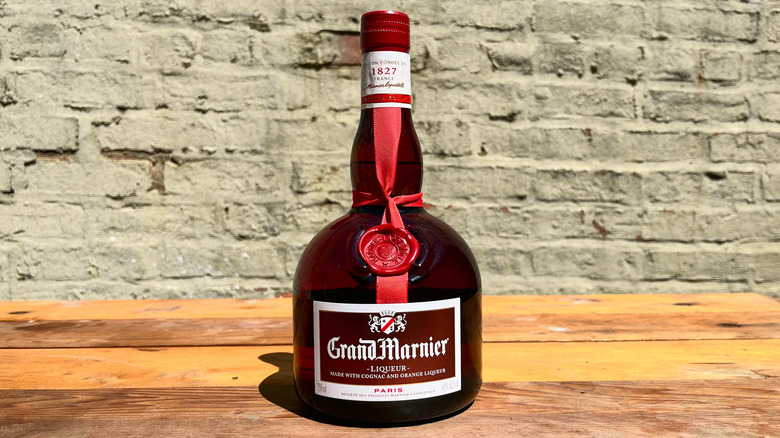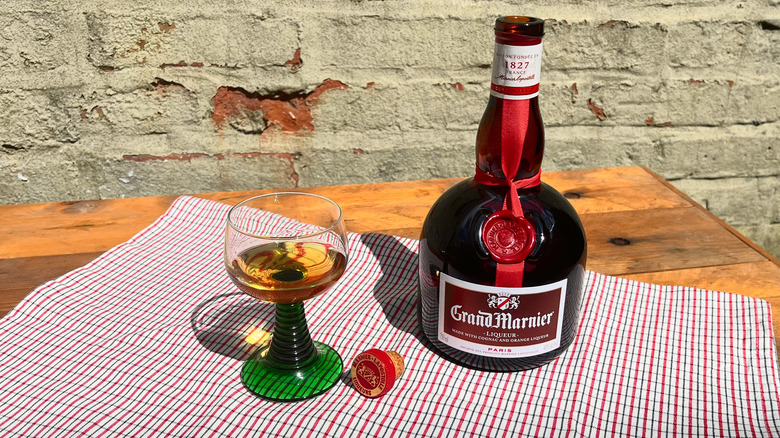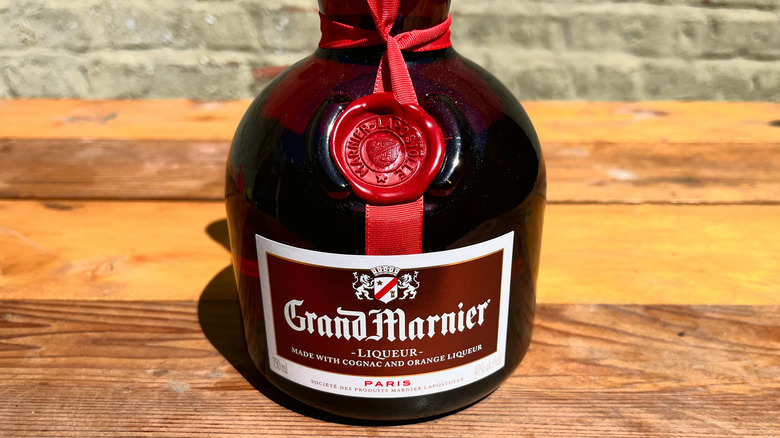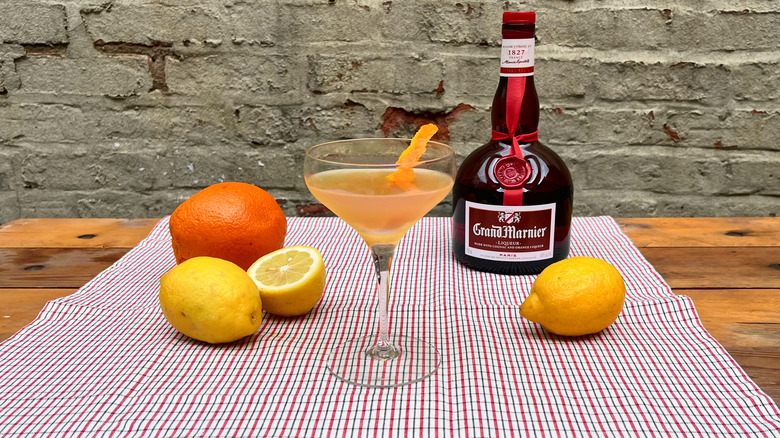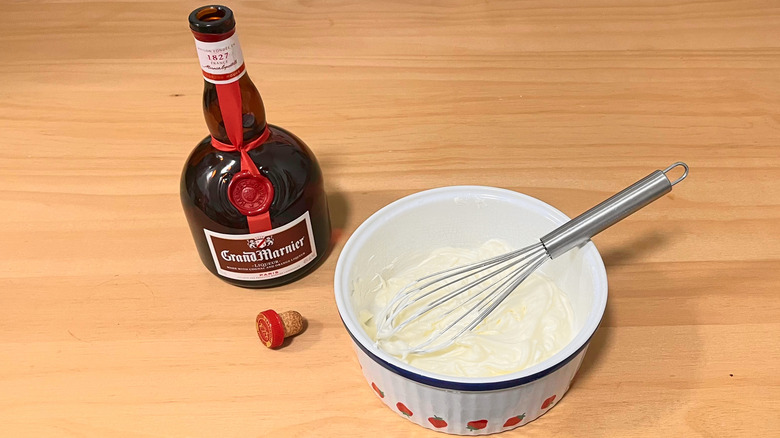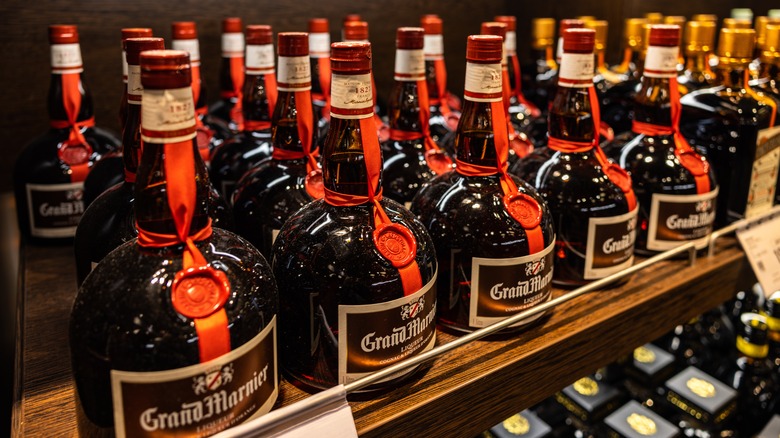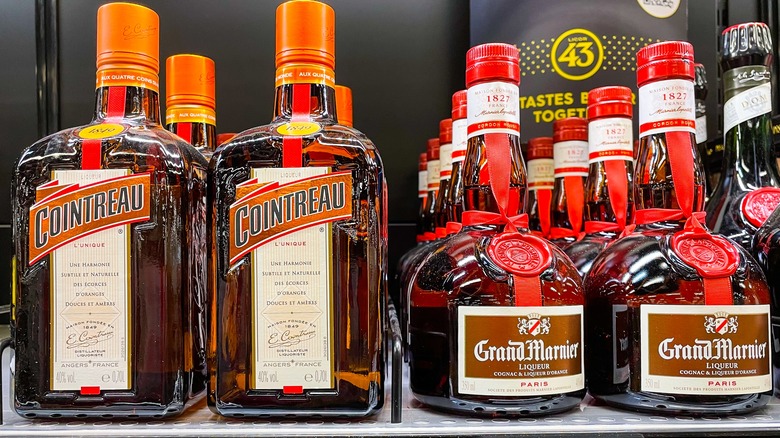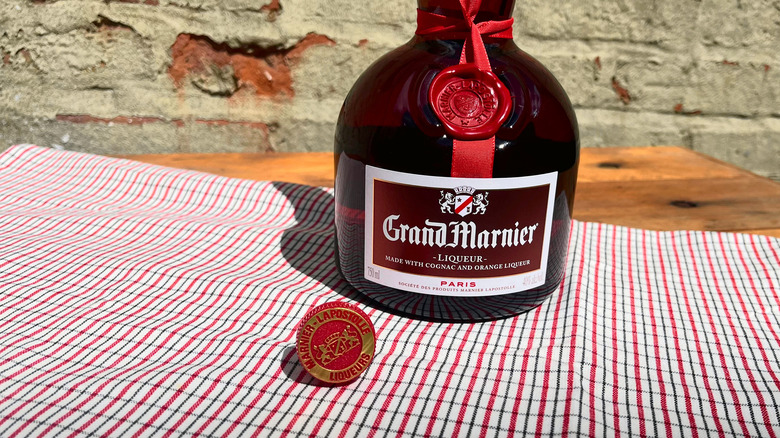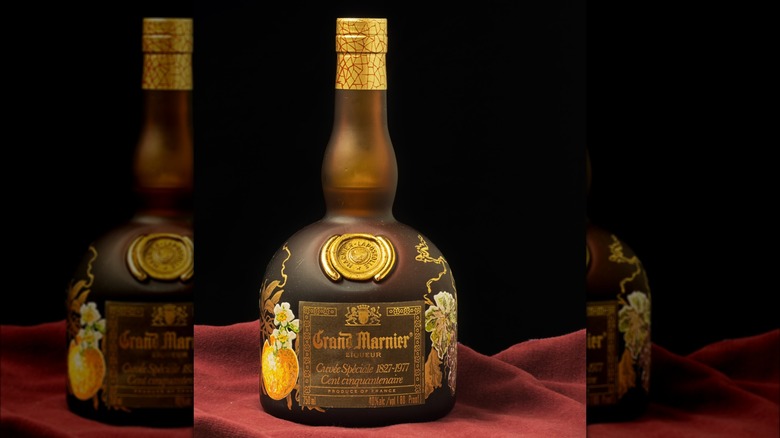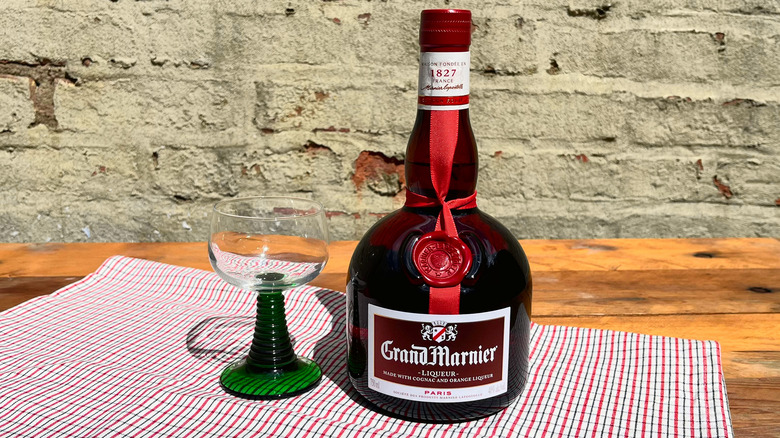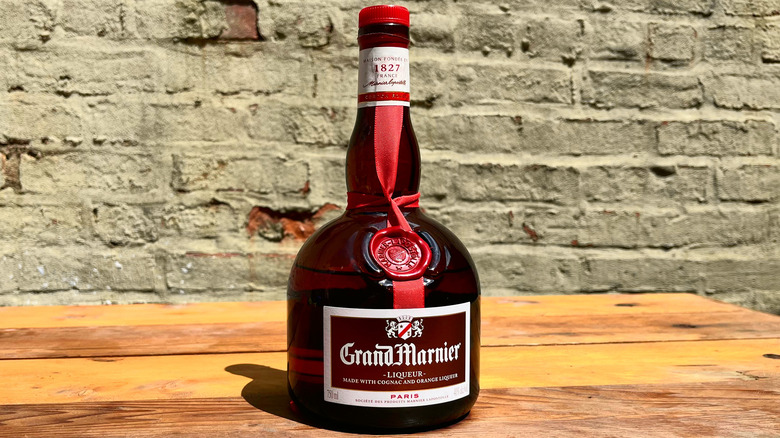Grand Marnier: The Ultimate Bottle Guide
Wrapped in red ribbon, Grand Marnier is a true gift. The French liqueur is globally recognized but too often seen as an ingredient rather than the special spirit that it is. There may be other orange liqueurs to choose from, but there are none that compare to Grand Marnier's unique blend with cognac. Both ingredients receive the same amount of discerning attention to create a balanced liqueur that's somehow a bit of everything: delicate, rich, sweet, bitter, sharp, strong, and smooth. If not served neat, it's often swirled into margaritas and other mixed drinks. Grand Marnier is a marvel in the world of cocktails, adored by mixologists for its versatility and equally savored by purists.
While it's a bar fixture around the world today, Grand Marnier reportedly had humble beginnings near Paris in the late 1800s. It's said that master distiller Jean Baptiste Lapostolle made a name for himself shortly after opening his own fruit liqueurs factory in 1827, but it was decades before cognac was thrown in the mix. Per the liqueur's website, the marriage of cognac and orange liqueur was all thanks to an actual marriage, that of Lapostolle's granddaughter, Julia, and Louis-Alexandre Marnier, son of the region's leading wine distributors. The two families merged in love and business, rapidly expanding its reach and reputation.
It was apparently Louis-Alexandre who thought to incorporate cognac. In 1880, the one and only Grand Marnier Cordon Rouge was born.
Some recommendations are based on first-hand impressions of promotional materials and products provided by the manufacturer/distributor/etc.
What does Grand Marnier taste like?
Grand Marnier has a powerful taste to match its regal title. Indeed, the citrus cognac broke the mold, and the brand credits Louis-Alexandre Marnier-Lapostolle's good pal and hotelier, César Ritz, for reportedly helping him develop a name this liqueur deserved.
Any citrus-forward spirit would presumably be light and refreshing, but Grand Marnier is more on the dark side. While sweet like syrup, there's a distinct bitterness that comes through from the orange rinds. The contrasting notes are flawlessly balanced by the smooth, velvety cognac with undertones of honey, vanilla, and toasted oak. Rather than overpowering the other flavors, the cognac helps to highlight them and create an entirely new libation.
Given its sweetness and rather high 40% ABV, Grand Marnier is an ideal digestif, and the French have seemingly always agreed. Trying the liqueur neat is the best way to note each flavor as it arrives on the palate, but different serving approaches bring out new characteristics. When served over ice or with a few drops of water, the alchemy shifts into a more delicate sip since its weight and mouthfeel are part of what gives it that round, bold finish. At first sip, it's easy to see why it's such a welcome addition to a margarita. Grand Marnier can serve as a sweetener that leads with orange rather than just sugar. While delicious, we feel it's too often limited as a mix-in, when it should really be the headliner.
How is this French liqueur made?
There's a reason there are only a few Grand Marnier copycats out there: It's not easy to replicate. It's said that the original Cordon Rouge recipe — still used almost 150 years later — took over 10 years to perfect. The brand claims the trick to the harmonious blend is painstaking precision and the finest ingredients. Brandies, or spirits distilled from fruit, are produced all over the world, but a true cognac can only be made in its namesake region of France. Grand Marnier uses ugni blanc grapes for a crisp eaux-de-vie that's then double distilled in copper stills and aged in Tronçais and Limousin oak casks to help make its renowned cognac.
Aside from other eaux-de-vies, Grand Marnier's secret is handpicked green, sun-dried orange peels. Contrary to the sweet taste, this liqueur is made with citrus bigaradia, better known as bitter orange. To achieve that signature flavor, Grand Marnier reportedly only utilizes Caribbean oranges and focuses on the natural flavor and oils of the rind rather than the fruit itself. After a long, meticulous process of rehydrating, dissecting, and hand sorting, the orange peels are soaked in alcohol for about eight days before being transferred into stills along with this freshly infused liquid. After being single distilled in copper, the result is a clean, vibrant orange essence.
Finally, the two concoctions are blended together with sugar and placed in huge oak barrels. One month later, Grand Marnier has aged to its finest.
How to drink Grand Marnier
Grand Marnier is a beverage of all traits. One of the best things about the liqueur is that there's no "right way" to enjoy it. Some traditionalists prefer it neat, while others drop a few ice cubes in their glass. In some cases, fans may not even know they're fans: If the word "grand" is introducing a cocktail's name, Grand Marnier is likely the not-so-secret ingredient.
The rich liqueur is a longstanding addition to classic cocktails like sidecars, margaritas, and cosmopolitans. It's one of the few premium spirits that can work with every type of alcohol — brown, clear, spicy, and sweet. As its own entity, this orange cognac also does well in the spotlight. Cocktails like the Grand Collins, a play on the time-honored Tom Collins, leave the gin out entirely and let Grand Marnier shine. The golden liqueur has an incredible way of accentuating ingredients rather than hiding behind them. Grand Marnier's rich orange flavor will brighten any existing citrus notes and work wonders as a flavored sweetener. Bartenders will often use it in place of other orange-flavored liqueurs like Cointreau and Triple Sec, but it deserves much more recognition, in our opinion. The cognac adds a smooth, creamy element that the others lack.
When sipped straight, Grand Marnier should technically be savored in the liqueur's designated glass, a round vessel on a short stem. Specifically known as a cognac glass or snifter, its shape helps direct the liqueur's fragrance right into your nose.
Cooking with this orange-flavored liqueur
Given its pronounced, layered flavor profile and syrupy nature, Grand Marnier makes for a fantastic cooking agent. Just as it can elevate cocktails, the orange spirit can enrich tons of dishes, some even savory. Citrus excels at brightening ingredients in all sorts of dishes, and Grand Marnier's distinctive aroma helps bring that punch of acidity to the surface. The flavors of bitter orange and vanilla translate well in decadent desserts like whipped cream and souffles, while the liqueur's sugars can help flavor and tenderize proteins.
Taste certainly plays a huge part, but it is Grand Marnier's viscosity that lends itself so well to cooking. The liqueur's sweetness and syrupy thickness make it fun to experiment with in the kitchen, swapping in as a sweetener or adding to an unexpected dish. Adding a few drops (a little bit goes a long way) of the liqueur to a sweet dish will do double duty by adding both sugar and flavor, rather than just the former. While it can help make the perfect glaze to drizzle over a sweet treat, it can also serve the same purpose with roast chicken. Whizzing Grand Marnier into a zesty orange compote will up the citrus and add depth, while keeping the chicken nice and juicy.
Due to its high alcohol content, Grand Marnier can even catch fire. This makes for a fun bonus when both cooking and making flaming libations — from flambé to flaming shots.
Is Grand Marnier worth the price?
Grand Marnier is the pinnacle of orange liqueurs and totally worth the price, especially when considering how long a bottle can last. Most of the creative Grand Marnier recipes mentioned wouldn't have been discovered if it weren't for innovative home chefs with an extra bottle on hand post-party. Given its bold taste and 40% ABV, plenty of recipes don't even call for 2 ounces. The signature label, Cordon Rouge, won't break the bank at around $30-45, depending on size, but some special editions can go for thousands.
With the red-sealed bottle's fame, it's easy to overlook Grand Marnier's other liqueurs, but the current list is impressive. The distillery stuck with the signature ingredients of bitter orange liqueur and cognac to create four other variations, all with varying ratios of cognac to liqueur. These special labels can range anywhere from $80 all the way to $6,000 depending on the rarity.
The priciest bottle in Grand Marnier's collection is its limited Cuvée Quintessence, which has been released annually since 2011. It's said to be made from barrels dating back to 1947 and demijohns from Paradis dating back even further. Much of the price feels dedicated to the gorgeous bottle that looks like it should be insured. The handmade woven-like crystal decanter was designed by Baccarat, France's top glassware maker, and adds some serious value to the bottle.
Grand Marnier vs. Cointreau
Cointreau is another orange liqueur and probably the most comparable to Grand Marnier. The two French conglomerates came about during the same era, with Cointreau's release just five years after Grand Marnier. The two are often interchangeable in cocktail recipes calling for that orange-forward flavor and matching high alcohol percentage, but there's nothing quite like Grand Marnier around. Though also made from oranges, Cointreau doesn't share the same depth that Grand Marnier delivers with its cognac foundation. Sans cognac, Cointreau is a tad lighter with a more one-dimensional citrus taste.
When orange essence is the main goal, Cointreau is a solid choice, but it doesn't stand alone very well, whereas Grand Marnier has the complexities to be enjoyed all by its lonesome. For common cocktails that benefit from an orange kick like margaritas or cosmopolitans, Cointreau will suffice, but the slightly more expensive Grand Marnier will always take first place as a solo sipper. Cointreau also doesn't hold the same magic in the kitchen, as the clear alcohol is more mellow. Celebrity chef and food writer Nigella Lawson utilizes orange liqueur in recipes like steeped Christmas fruits, but she prefers Grand Marnier for its layered flavors and consistency.
Triple Sec is another popular fruity liqueur hailing from France with a sweeter finish and a friendlier price tag. If it's all that's available, it will supply that potent citrus a recipe is calling for, but it's definitely the budget option.
From family to Campari
After a reported decade of trials and tribulations, Louis-Alexandre Marnier-Lapostolle finally mastered the recipe that skyrocketed the brand to success, but he couldn't have done it without the family. Indeed, if it wasn't for his and Julia Marnier-Lapostolle's romance, Grand Marnier may have never come to be. Between Jean Baptiste Lapostolle's distilling expertise and Louis-Alexandre's years of knowledge in the French wine trade, the two were seemingly unstoppable. It seems Parisians swiftly loved not only the golden liqueur, but the family's legacy.
Recognizing the intrigue and attention for its signature Grand Marnier, especially after winning numerous medals in the late 19th and early 20th centuries, the brand decided to throw all its eggs in one basket and focus on marketing the liqueur as widely as possible. Over 150 countries sold Grand Marnier by the '60s, and it's ubiquitous on store shelves these days. The Marnier-Lapostolle family graced the world with over six generations of smooth, citrus cognac, and today, the family is still on the map — just a little to the left. After selling the $761 million brand to Gruppo Campari in 2016, the Marnier-Lapostolle family carried on in the industry with a new titan in mind: Chilean wine.
As for the future of Grand Marnier, Campari couldn't be more optimistic. After the deal kicked off, the company's then-chief executive Bob Kunze-Concewitz told The New York Times, "With Grand Marnier, we further consolidate our position as the leading purveyor of premium liqueurs and bitter specialties worldwide."
The Marnier-Lapostolle family's private collection
With a past so rich in cognac, the Marnier-Lapostolle family's massive private collection is only logical, but it's probably more impressive than you might imagine. Going all the way back to 1906, the cognac royalty must have had an incredible array of blends lining its cellar walls. Luckily for the rest of the world, Grand Marnier's been willing to share.
Rather than simply admiring and occasionally sipping these precious cognacs, the brand utilizes them to develop new limited editions, like those exclusive bottles of Grand Marnier Quintessence. Produced in small batches of 1,000 or less and released each year, that particular label is developed from Grande Champagne and a few select bottles from its own collection.
The Marnier family didn't have to sacrifice too many of these rare treasures given the limited run, and even less so in 2024, with only 500 of the exclusive bottles having been released. Grand Marnier's master blender Patrick Leger finds great joy in employing the Marnier-Lapostolle's personal stash of vintage cognac blends to inspire new creations. Its vintage cognacs can add spice and even more depth to new bottles. As Leger enthusiastically told CTV News when speaking of the 2024 Grand Marnier Quintessence, "Most of the time, you can cry, because it's something that you can't imagine."
A Grand Marnier cocktail has ties to the Moon
Grand Marnier's reputation often precedes the drink itself. After its 1880 debut, the liqueur's popularity took off into the new millennium, becoming a hallmark drink of the 20th century. Its French heritage offers an intriguing backstory, and admiration for the drink bumped it up to the top shelf. Its grandiosity admittedly couldn't be denied, especially after it was famously served to the affluent guests on the Titanic in 1912. Grand Marnier's distinguished history only continued to expand over the years, with one of the most notable instances being tied to the 1969 Moon landing.
Joe Gilmore, a well-known London bartender, created the moonwalk cocktail in honor of Neil Armstrong and Buzz Aldrin's first steps on the Moon. The cocktail is as celebratory as the day perhaps was, bubbling with champagne, grapefruit juice, rosewater, and none other than Grand Marnier. It was apparently the perfect cocktail to welcome the astronauts back down to Earth. "The Savoy sent it off in a flask," Gilmore told Wonderland magazine in 2008, "and I received a letter back from Neil Armstrong thanking us and saying it was the first drink they had when they came out of quarantine."
As lead bartender of Savoy Hotel's popular American Bar, Gilmore managed to garner the Grand Marnier cocktail almost as much attention as the Apollo 11, as least in the pub scene. Drinkers quickly picked up on the liqueur's adaptability, and it started popping up in cocktail after cocktail.
Grand Marnier's signature bottle shape is trademarked
That ribbon-adorned bottle with the distinguishable red seal is actually exclusive to just one bottle in Grand Marnier's collection: Cordon Rouge. It's the brand's most widely used product and likely what you've seen illuminated behind the bar or sipped in your Singapore sling. It's all about the branding — the bottle, label, wax seal, and ribbon are all instantly familiar. The first bottle of Grand Marnier's orange cognac introduced in 1880 hardly resembles today's signature bottle. Per Grand Marnier's historic photos, it was made of stoneware rather than glass and resembled a cartoonish XXX-labeled poison bottle, but instead with "GRAND MARNIER" etched into the neck of the bottle.
Today's alcohol producers often push the boundaries with funky bottle shapes and campaigns — just take a look at Crystal Head's skull-shaped bottle. But back in 1892, it seems Louis-Alexandre Marnier-Lapostolle was the only one. It's said that he creatively designed the bottle after a cognac still and employed Baccarat to help perfect the crystal glassware. It became synonymous with the liqueur, and to avoid any competitors hijacking his stunning design, Louis-Alexandre trademarked the unique bottle.
Before Grand Marnier Cordon Rouge was dressed in red, it was bound with a yellow ribbon. The official seal and red ribbon were the iconic finishing touches that still help folks identify the bottle over 100 years later. Grand Marnier has stood the test of time in that long-necked bottle, serving as a marker of Parisian history and cocktail culture.
